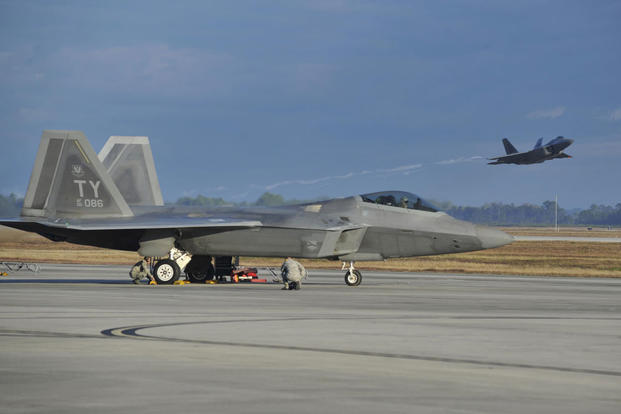Air Force Secretary Heather Wilson raised the possibility Friday that F-22 Raptors, the nation's most advanced fighters, may never return permanently to storm-ravaged Tyndall Air Force Base in Florida's Panhandle.
"That has not been determined," Wilson said in a conference call with defense reporters Friday when asked whether the more than 50 F-22s that had been at Tyndall before Hurricane Michael hit would once again be stationed at the base that served as the main training installation in the Air Force for F-22 pilots. "We haven't made a decision on that."
While Tyndall is undergoing repairs that could take several years, the 43rd and 2nd Fighter Squadrons' F-22 Fighter Training and T-38 Adversary Training units will relocate to Eglin Air Force Base, about 60 miles from Tyndall, the Air Force said in a release.
The 372rd Training Squadron, Detachment 4, also will relocate with the F-22 Fighter Training units to Eglin, the Air Force said.
In addition, personnel and F-22s from the 95th Fighter Squadron will relocate to Langley AFB, Virginia; Joint Base Elmendorf-Richardson, Alaska; and Joint Base Pearl Harbor-Hickam, Hawaii, the Air Force said.
The Air Force also will shift the Non-Commissioned Officer Academy based at Tyndall to four other locations: McGhee Tyson Air National Guard Base in Tennessee, Maxwell-Gunter Air Force Base in Alabama, Keesler Air Force Base in Mississippi and Sheppard Air Force Base in Texas.
Much of Tyndall, including all of the base housing, suffered major damage when Michael came ashore in Florida on Oct. 10. All 11,000 personnel and family members were safely evacuated before the storm hit and the vast majority of the F-22s also were flown to other bases.
However, a number of F-22s -- the Air Force has still not said how many -- that were undergoing repairs remained behind and suffered unspecified damage levels when the roofs were torn off some of their hangars.
Wilson indicated that the damage to the F-22s that remained at Tyndall during the storm may not have been severe. She again did not give a number, but said most of the F-22s that remained behind would be flown out of Tyndall by Nov. 6.
Wilson stressed that Tyndall would be restored but said it could take "several years." She cited the example of Keeler Air Force Base in Biloxi, Mississippi, which took five years to recover from the damage caused by Hurricane Katrina.
Wilson also had no initial estimates on the costs for the restoration of Tyndall. She said a civil engineering evaluation of the projected costs had yet to be completed. The Air Force said that the money to rebuild "will require supplemental funding from Congress."
Most of the Tyndall families would be able to return "within the next three months," Wilson said, with the exception of the family members among 500 Tyndall personnel who were being reassigned to other bases.
"We are focused on taking care of our airmen and their families and ensuring the resumption of operations," Wilson said. "We're working hard to return their lives to normalcy as quickly as possible."
In a statement, Air Force Chief of Staff Gen. David Goldfein said the expectation was that all airmen who had been stationed at Tyndall before the storm would have some certainty on their future assignments by the end of the year.
"By the winter holidays and in many cases well before, we expect all our airmen -- military and civilians -- to have certainty about their options, so that everyone is either on a path or already settled," Goldfein said.
One of the units that will resume operations at Tyndall by Jan. 1 was the 601st Air Force Operations Center, which tracks foreign aircraft for U.S. Northern Command and the North American Aerospace Defense Command (NORAD), the Air Force said.
According to the Air Force release, other Tyndall units expected to resume operations in the coming months included the 337th Air Control Squadron, the Air Force Medical Agency Support team, the Air Force Office of Special Investigations, the 53rd Air-to-Air Weapons Evaluation Group and the 823rd Red Horse Squadron, Detachment 1.
-- Richard Sisk can be reached at richard.sisk@military.com.














